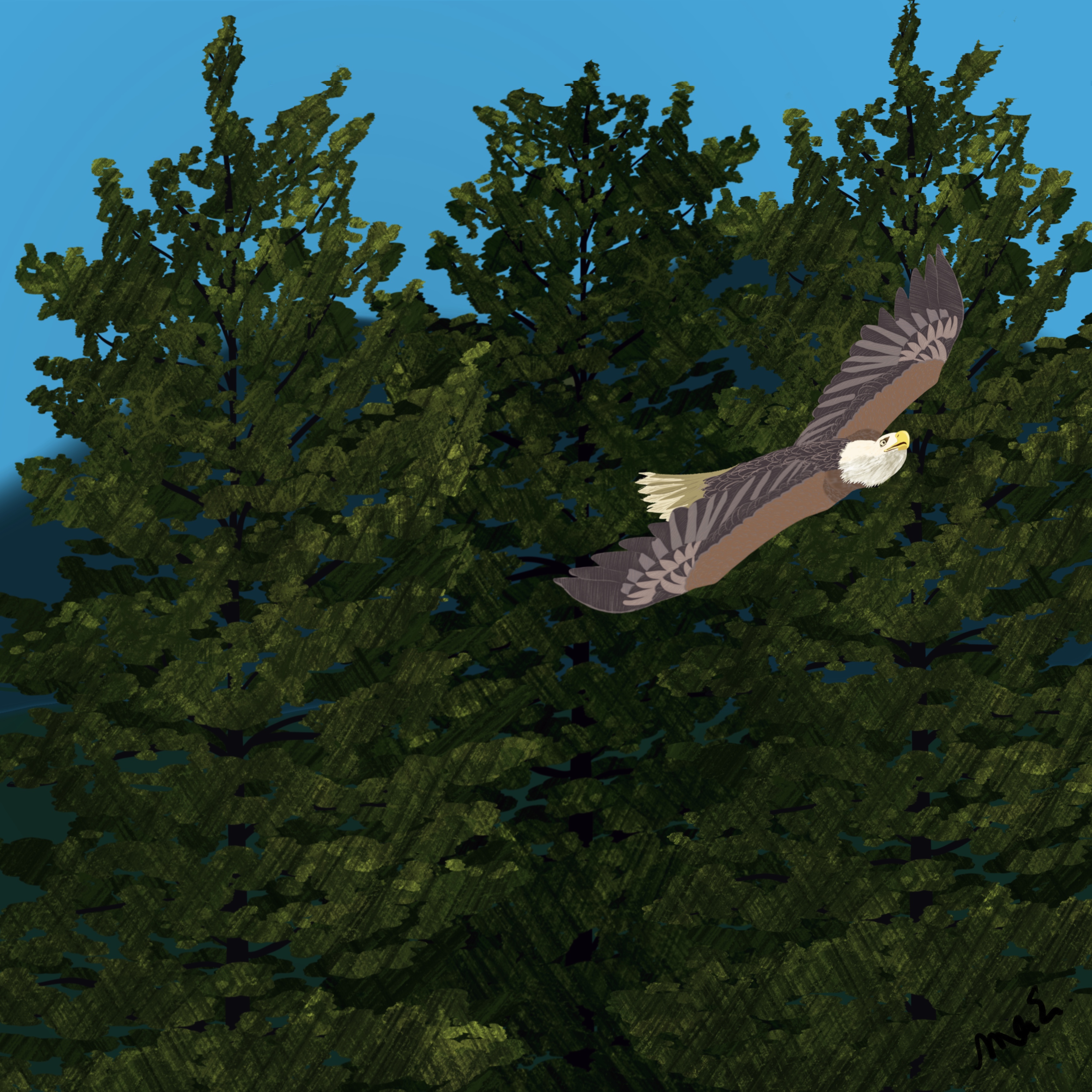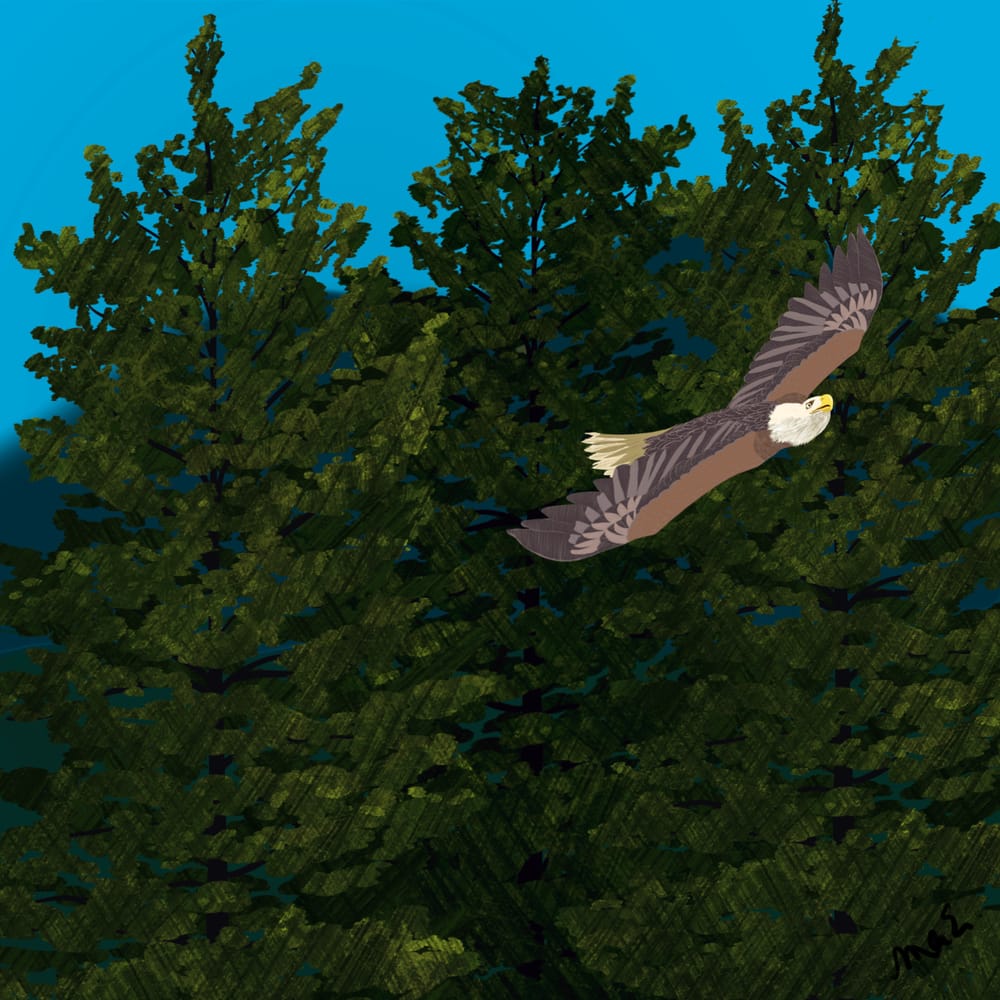White Pines: Colossal in Many Ways
by: Paul Hetzler
The eastern white pine (Pinus strobus) isn’t really a crop-bearing tree, but it has borne priceless “fruit” for American democracy. Physically as well as culturally massive, there are many accounts from the early 1800s of white pines over 200 feet tall being harvested. One credible report pegs a white pine at 247 feet, and unverified accounts have claimed that 300-foot-tall leviathans were cut back then. It’s a long-lived species, with 400 years considered a rough maximum. Working for a tree service in the Adirondacks in the early ‘90s, I once tallied 450 rings on a storm-thrown specimen.
The white pine is the official tree of Ontario, and Maine and Michigan as well. Standing 180 feet, 10 inches tall, the current U.S. champion is located in Cook Forest State Park in Pennsylvania. Sadly, one of New York State’s tallest white pines, which I had visited several times, toppled in 2021. At 160 feet, 10 inches, it was in a stand of old-growth habitat near Paul Smith’s College. In today’s second- and third-growth forests, the average mature white pine is often between 100 and 130 feet tall, with diameters of 25-35 inches.
In terms of identification, it’s the only native pine out East that bears needles in bundles, or fascicles, of five: one for each letter in W-H-I-T-E. (Just to be clear, the letters are not actually written on the needles!) White pine branches tend to swoop gracefully upwards toward their ends, and the tree produces attractive, 8- to 16-inch-long cones with resin-tipped scales.
White pine is renowned for its wide and clear (knot-free), straw-coloured lumber used for flooring, panelling, and sheathing, as well as for structural members. Much of New England was built on white pine, and in some old homes, original pine floorboards 20+ inches wide can still be found.

As impressive as its lumber is, white pine’s most precious gifts are intangible. In his book Forgotten Founders, Bruce E. Johansen documents the link between the modern Western understanding of democracy, and the Haudenosaunee (Iroquois) Confederacy, whose symbol is the white pine.
According to Haudenosaunee oral history, more than 1000 years ago in what’s now upper NY State, as well as parts of Ohio, Pennsylvania, and Ontario, five nation-states were convinced by a prophet known as the Peacemaker (Dekanawidah) that they’d all benefit by joining in a federation. (Some non-Native historians have placed this event as late as 1660, despite the fact that’s nearly 50 years after a seminal Haudenosaunee treaty with the Dutch government.)
The Peacemaker held that the white pine, with its five needles joined at the base, would be an apt symbol for the unique democratic federal structure he proposed. At the time, it comprised five nations: the Seneca (Onödowa'ga:'), Oneida (Onyota'a:ka), Onondaga (Onöñda'gega'), Cayuga (Gayogohó:no), and Mohawk (Kanienke’haka).
Each member nation manages its own internal affairs through elected officials, but matters involving one or more nations are resolved at the federal level. The Haudenosaunee federal government is composed of fifty elected chiefs who sit in two legislative houses; the Elder Brothers and Younger Brothers. There is a single elected Executor or Grand Chief (Adodarhoh), who among other things acts as a tie-breaker in the event the legislative bodies disagree after deliberating an issue.
These and other tenets of Haudenosaunee governance are codified in The Great Law of Peace, or Kaianere'kó:wa. It is an oral constitution, and traditional chiefs are expected to know it by heart. I had the good fortune to have attended the first recitation of The Great Law ever done in the English language. It was in 1992 on Six Nations of the Grand River Territory near Brantford, Ontario, and took nine days for Oneida Snipe Clan chief Jake Thomas to recite it.
Though ravaged by colonization, The Great Law is fiercely embraced by a segment of the population today. Only women can vote under this structure, a fact which confounded European men, and was one reason that colonizers worked hard to subvert it and install more pliable, male-only councils. Haudenosaunee women, primarily the elders or clan mothers, still have the sole power to depose a chief who is not acting in the public’s best interest. The clan mothers also can veto any law they deem short-sighted, in this sense collectively acting as a further check against abuse of power.
The white pine is often called “the tree of peace” by the Haudenosaunee. The Peacemaker told the people to bury their weapons of war forever beneath its roots, and oral history notes that after the formation of the Confederacy, generations passed without war. The Great Law allows other nations to apply for membership by tracing the white roots of peace, as they are termed, back to their source.
In 1722, a sixth nation, the Tuscarora (Skarù:ręˀ), did just that when they were admitted to the Confederacy after being driven from their homeland in present-day North Carolina. The structure of The Great Law was not altered, however, and Tuscarora leaders vote by proxy through the Oneida.
For the Haudenosaunee, the white pine remains an enduring representation of their culture. As described in The Great Law, a bald eagle sits at its top, a bundle of five arrows in its talons denoting strength in unity. The purpose of the sharp-sighted bird atop the pine is to watch for perils that could destabilise the government – namely greed and selfishness, as Chief Thomas explained in 1992.
As Donald A. Grinde lays out in his book Exemplar of Liberty: Native America and the Evolution of Democracy, key Colonial figures such as Thomas Jefferson, John Adams, James Madison, and especially Benjamin Franklin, deeply admired The Great Law.
As a result, Haudenosaunee chiefs were invited to address the Continental Congress and act as advisers as America’s Founding Fathers were drafting the Constitution. In other words, the US Constitution is directly and deliberately based on The Great Law, the symbol of which is the white pine.
Among the early US flags were a series of Pine Tree flags. And the white pine depicted on the state seal of Vermont has 13 branches, a nod to the importance of The Great Law in the formation of the USA. We took the bald eagle from its perch at the white pine’s summit, and adopted it as America’s official bird – the eagle appears on most currency, in its talons a bundle of 13 arrows symbolizing strength in unity, or E Pluribus Unum.
North American women’s-rights pioneers of the late 1800s, especially Matilda Jocelyn Gage, credit Haudenosaunee women as the inspiration for demanding equal treatment. In her book Women, Church and State, Gage makes this connection explicitly. She writes of being astonished that she was able to walk alone at night through a Seneca village without fear of sexual assault, a sad commentary on the lack of respect for women in “civilized” society. It is no accident that the Women's Rights National Historical Park is located in Seneca Falls, NY – virtually in the center of Haudenosaunee territory.
Thus, the white pine is fundamentally linked to contemporary women’s rights, as well as to modern democracy. Some pretty amazing “crops” from this conifer, I’d say.
By Paul Hetzler
Paul Hetzler for The Saturday Evening Post TI Life He is a former Cornell Extension educator, and he also writes books! Be sure to check out the description of his books and I promise you will not only smile but you will want to give them as gifts for the next birthday - Just the titles makes you smile! Head of the Class: Smart as a Slime Mold, Shady Characters: Leprechaun Trees, Plant Vampires and Caterpillar Soup.
https://www.amazon.ca/dp/B09DN16VYC https://www.amazon.ca/dp/B08BR6NHDY amazon.com



